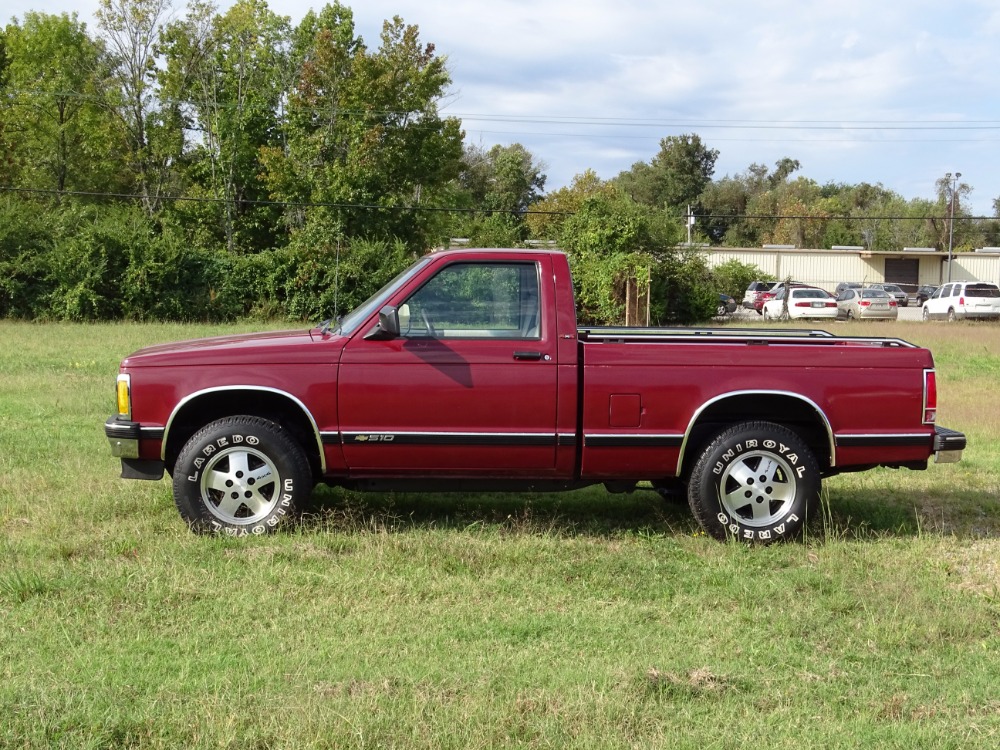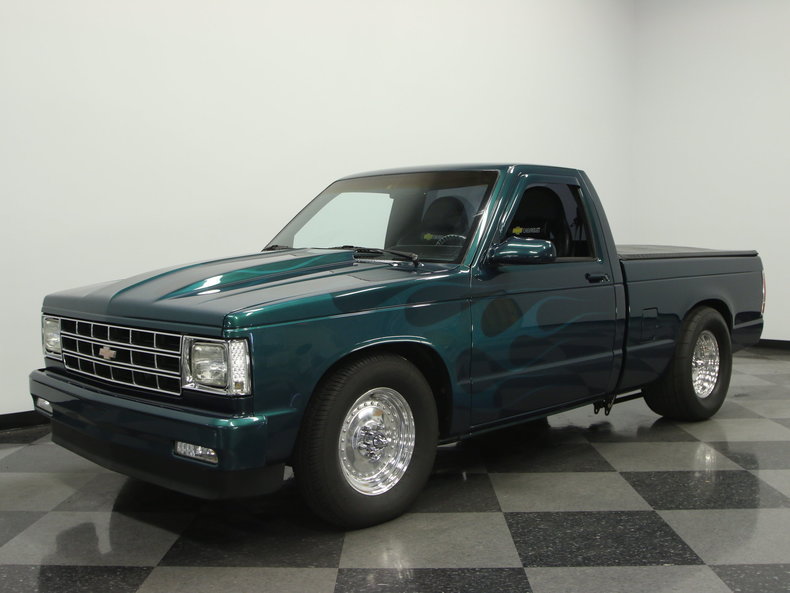Used S-10 Pickup Trucks For Sale: A Comprehensive Buyer’s Guide pickup.truckstrend.com
In the ever-evolving landscape of pickup trucks, some models simply refuse to fade into obscurity. The Chevrolet S-10 pickup is a prime example. Introduced in 1982, this compact workhorse quickly carved out a niche for itself, offering a practical, no-nonsense alternative to full-sized trucks. Even years after its discontinuation in 2004 (replaced by the Colorado), the S-10 remains a highly sought-after vehicle in the used market. For buyers on a budget looking for a reliable, versatile, and manageable truck, a used S-10 represents an excellent value proposition.
This comprehensive guide will delve into everything you need to know about finding, evaluating, and owning a used S-10, helping you make an informed decision and potentially drive home a classic that still has plenty of life left.
Used S-10 Pickup Trucks For Sale: A Comprehensive Buyer’s Guide
Why Consider a Used S-10? The Enduring Appeal
The S-10’s continued popularity isn’t by accident. Several factors contribute to its enduring appeal:
- Affordability: Compared to newer or full-sized trucks, used S-10s are remarkably budget-friendly, making them accessible to a wide range of buyers, from first-time truck owners to those needing a dedicated work vehicle.
- Reliability (with caveats): While no older vehicle is without its quirks, the S-10, particularly models with the 4.3L V6 engine, are known for their robust powertrains and general durability when properly maintained.
- Versatility: Whether you need a truck for hauling light loads, tackling DIY projects, commuting, or even some light off-roading, the S-10 can handle it. Its compact size makes it maneuverable in urban environments and easy to park.
- Compact Size: For many, the sheer size of modern full-size trucks is overkill. The S-10 offers a more nimble and fuel-efficient (relative to full-size) package without sacrificing essential utility.
- Customization Potential: The S-10 has a huge aftermarket support system, making it a popular choice for modifications, from lift kits and off-road tires to performance upgrades and aesthetic enhancements.
- Simplicity of Repair: With fewer complex electronics than modern vehicles, many repairs on an S-10 can be handled by a home mechanic, potentially saving on labor costs. Parts are also widely available and generally inexpensive.
Key Generations and Notable Features
The S-10 saw two distinct generations, each with its own characteristics:
- First Generation (1982-1993): These models are characterized by their more utilitarian, boxy design. They were offered with a range of engines, including various 2.5L four-cylinders and the venerable 2.8L V6, eventually superseded by the more powerful 4.3L V6 in later first-gen models. Interiors were basic but functional. Finding these in pristine condition can be challenging due to age and typical work use.
- Second Generation (1994-2004): This generation received a significant overhaul, boasting a more aerodynamic and rounded exterior design, a more refined interior, and improved ride quality. The 4.3L V6 became the dominant engine, offering a good balance of power and efficiency for its class, alongside the reliable 2.2L four-cylinder. Extended cab and eventually crew cab (late 2nd gen) options became more prevalent, catering to those needing more passenger space. This generation is generally more comfortable and offers more modern features, albeit still basic by today’s standards.

What to Look For When Buying a Used S-10: A Buyer’s Checklist
Purchasing any used vehicle requires diligence, and the S-10 is no exception. Given their age, specific areas warrant close inspection.

Engine Options: Power vs. Economy
- 2.2L 4-Cylinder: Primarily found in 2WD models, this engine is known for its excellent fuel economy and robust reliability. It’s perfectly adequate for light hauling and daily commuting, but don’t expect exhilarating acceleration or heavy towing capacity. Check for oil leaks around the valve cover and front timing cover.
- 4.3L V6: The workhorse of the S-10 lineup, this engine provides significantly more power and torque, making it ideal for heavier loads, towing, and 4WD applications. It’s generally very durable. Common issues include intake manifold gasket leaks (listen for vacuum leaks or look for coolant consumption) and issues with the "spider" fuel injector assembly, which can cause misfires.
Transmission and Drivetrain
- Manual vs. Automatic: Both options were available. Manual transmissions (especially the NV3500) are generally robust. Automatic transmissions (4L60E) are common but can develop issues with age, such as delayed shifts, slipping, or hard engagement. Test drive thoroughly through all gears.
- 2WD vs. 4WD: Decide based on your needs. 4WD systems (especially the electronic push-button variants) should be tested to ensure proper engagement in both 4-High and 4-Low. Listen for grinding noises during engagement or disengagement. Check for transfer case leaks.
Body Styles
- Regular Cab: Two doors, smallest interior. Good for pure utility.
- Extended Cab: Two or three doors (later models), offering a small jump seat area behind the main seats. Good for occasional extra passengers or secure storage.
- Crew Cab (2001-2004): Four full doors, a true back seat. These are less common but offer the most passenger comfort.
Common Issues and Trouble Spots
Due to their age and typical use, S-10s often exhibit certain wear patterns:
- Rust: This is the biggest enemy. Inspect the frame thoroughly, especially near suspension mounting points and the rear axle. Check rocker panels, cab corners, wheel wells, and the bed floor. Surface rust is common; severe structural rust is a deal-breaker.
- Suspension Components: Worn ball joints, tie rods, control arm bushings, and leaf springs are common. Listen for clunking noises over bumps and check for excessive play in the steering.
- Brakes: Check for worn pads and rotors. The ABS module can fail, leading to an illuminated ABS light.
- Electrical Issues: Dash lights, power windows, and HVAC fan motors can sometimes act up. Check all electrical accessories during your test drive.
- Steering Play: Some play in the steering linkage is normal for an older truck, but excessive looseness could indicate worn steering box or linkage components.
- Exhaust System: Check for rust and leaks, especially around the manifold and catalytic converter.
The Pre-Purchase Inspection (PPI)
Always, always, always have a trusted mechanic perform a pre-purchase inspection. They can spot issues you might miss and provide an unbiased assessment of the truck’s condition, potentially saving you thousands in future repairs.
Test Drive Checklist
- Start the engine cold. Listen for unusual noises (knocks, ticks, squeals).
- Check all lights, wipers, horn, and HVAC.
- Drive at various speeds, including highway.
- Test brakes for pull or pulsation.
- Listen for suspension noises over bumps.
- Engage and disengage 4WD (if equipped).
- Check for smooth transmission shifts (both up and down).
- Note any warning lights on the dashboard.
Tips for Finding the Right Used S-10
- Online Marketplaces: Websites like Craigslist, Facebook Marketplace, Autotrader, and local dealership sites are good starting points.
- Private Sellers vs. Dealerships: Private sellers often offer lower prices but "as-is" sales. Dealerships might have slightly higher prices but could offer limited warranties or reconditioning.
- Vehicle History Report: Invest in a CarFax or AutoCheck report. It can reveal accident history, previous owners, service records, and title issues (salvage, flood, etc.).
- Be Patient: The right S-10 might not appear overnight. Don’t rush into a purchase.
- Set a Budget: Beyond the purchase price, factor in potential immediate repairs, insurance, and routine maintenance.
Maintaining Your Used S-10
Once you’ve purchased your S-10, proactive maintenance is key to its longevity:
- Regular Oil Changes: Follow the manufacturer’s recommendations.
- Fluid Checks: Regularly check transmission fluid, differential fluid, coolant, and brake fluid.
- Tire Rotation and Alignment: Essential for even tire wear and good handling.
- Brake Inspection: Check pads, rotors, and fluid regularly.
- Rust Prevention: Wash off road salt in winter, address any new rust spots promptly.
- Address Issues Promptly: Don’t let small problems become big, expensive ones.
Potential Challenges and Solutions
- Finding Low-Mileage Examples: S-10s were often work trucks, so high mileage is common. Focus on maintenance history over just odometer readings.
- Age-Related Wear: Expect some components to be original and nearing the end of their lifespan. Budget for replacements.
- Fuel Economy: While better than full-size trucks, the 4.3L V6, especially with 4WD, isn’t a gas sipper. The 2.2L offers better economy.
- Safety Features: Older S-10s lack many modern safety features like multiple airbags, traction control, or stability control. Drive defensively.
Used S-10 Pickup Truck Price Table (Estimated)
Please note: These prices are highly variable and depend on condition, mileage, region, options, and market demand. This table provides a general range for a truck in fair to good condition. Excellent, low-mileage examples or highly modified trucks can command higher prices.
| Generation | Year Range | Engine | Transmission | Drivetrain | Cab Style | Price Range (USD) | Notes |
|---|---|---|---|---|---|---|---|
| First Gen | 1982-1993 | 2.5L 4-Cyl | Manual/Auto | 2WD | Regular | $1,500 – $4,500 | Basic, more prone to rust. |
| 2.8L/4.3L V6 | Manual/Auto | 2WD/4WD | Regular/Ext. | $2,000 – $6,000 | V6 models more sought after. | ||
| Second Gen | 1994-2004 | 2.2L 4-Cyl | Manual/Auto | 2WD | Regular/Ext. | $2,500 – $7,000 | Good fuel economy, light duty. |
| 4.3L V6 | Manual/Auto | 2WD | Regular/Ext. | $3,000 – $8,500 | Most common, versatile. | ||
| 4.3L V6 | Manual/Auto | 4WD | Regular/Ext. | $4,000 – $10,000 | Higher demand, better utility. | ||
| 2001-2004 | 4.3L V6 | Auto | 2WD/4WD | Crew Cab | $5,000 – $12,000 | Rarest, most passenger room. |
Frequently Asked Questions (FAQ)
Q: Is the S-10 a reliable truck?
A: Generally, yes, especially the 4.3L V6 and 2.2L 4-cylinder engines. However, like any older vehicle, reliability heavily depends on past maintenance and current condition. A thorough pre-purchase inspection is crucial.
Q: What’s the best engine for a used S-10?
A: For power and versatility, the 4.3L V6 is widely considered the best choice. For maximum fuel economy and light-duty use, the 2.2L 4-cylinder is excellent.
Q: Are parts for the S-10 expensive or hard to find?
A: No, quite the opposite. Due to its popularity and long production run, parts for the S-10 are readily available at most auto parts stores and are generally very affordable.
Q: What’s the towing capacity of an S-10?
A: Towing capacity varies significantly by engine, drivetrain, and specific configuration. A 2.2L 2WD might tow around 2,000 lbs, while a 4.3L V6 2WD could tow up to 5,500 lbs (with proper equipment). Always check the specific truck’s owner’s manual or a reliable towing guide.
Q: Is the S-10 good for off-roading?
A: 4WD S-10s, especially those with the ZQ8 (sport) or ZR2 (off-road) packages, can be very capable light off-roaders with the right tires and minor modifications. Their compact size makes them maneuverable on trails.
Q: What’s the difference between a Chevy S-10 and a GMC Sonoma?
A: They are essentially the same truck, built on the same platform with identical mechanical components. The differences are primarily cosmetic, such as grilles, badges, and trim levels.
Conclusion: The Enduring Value of the S-10
The Chevrolet S-10 pickup truck, in its used form, represents a compelling option for anyone seeking an affordable, versatile, and relatively straightforward truck. While its age means potential buyers must be diligent in their inspection and realistic about maintenance, the S-10’s core strengths—its robust design, widespread parts availability, and enduring utility—make it a smart choice. With careful selection and consistent care, a used S-10 can continue to serve its owner reliably for years to come, proving that sometimes, the best value isn’t found in the newest models, but in the proven workhorses of the past.

